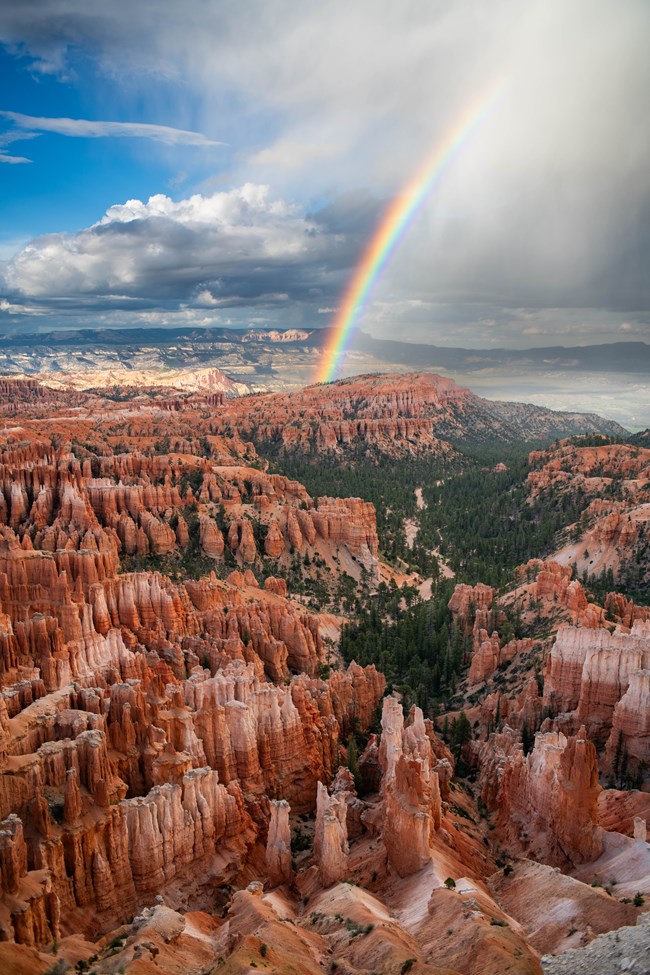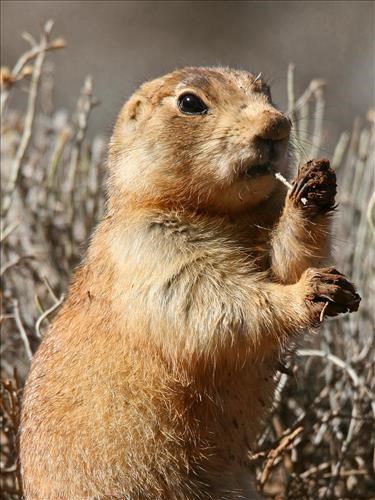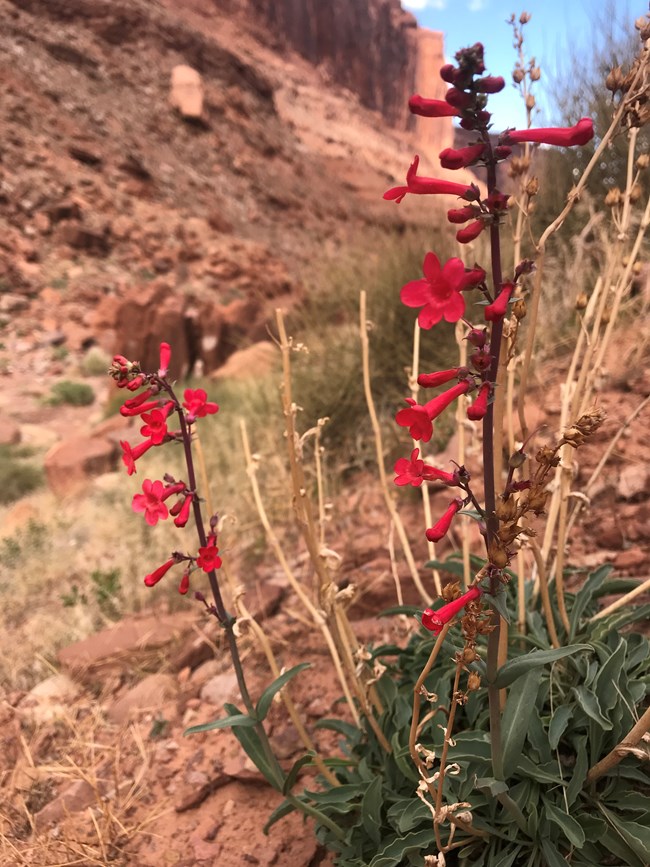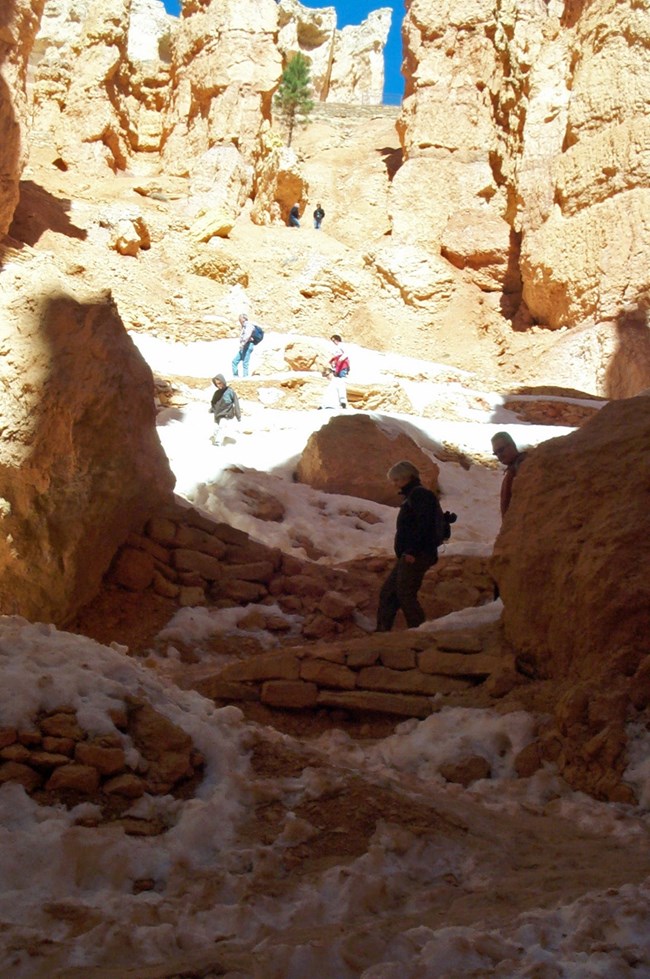The following information is summarized from the Northern Colorado Plateau Network monitoring plan, published in 2004. Some details may have changed.
Park History and Purpose

NPS/Peter Densmore
Bryce Canyon is known internationally for its unusual scenic beauty and scientific interest and importance found in its brightly colored and towering formations of limestone, clay, and silt, created primarily by the water’s erosive forces. The formations, which range in shades of red and white, are a brilliant contrast to the colorful lowlands east of the park and the timbered hillsides and plateaus to the west. The vast, panoramic views from within the park to the outlying valleys and canyons add an outstanding quality to the park’s aesthetic values. The park also has a rich cultural background, ranging from numerous archeological sites to nationally registered historic architecture.
Bryce Canyon National Park was originally established as a National Monument in June 1923, by Presidential Proclamation (number 1664). The purpose was to reserve certain lands within the Powell National Forest known as “Bryce Canyon” because of unusual scenic beauty, scientific interest, and importance. The proclamation identified that the public interest would be promoted by reserving as much land as necessary for the proper protection as a national monument. In June 1924, additional legislation established Utah National Park. At this time, all the lands within the boundary of the original national monument were acquired by the federal government and henceforth subject to the provisions of the National Park Service (NPS) Organic Act of 1916. In February 1928, the name was changed to Bryce Canyon National Park, and administration transferred to the NPS in September. During the intervening months, 11 sections of land were added to the park, bringing its size to 5,860 hectares (14,480 acres).
In January 1931, President Hoover authorized a proclamation (number 1930) that more than doubled the park’s size, resulting in a new land base of 12,367 hectares (30,560 acres). This expansion extended boundaries south and west along the Paunsaugunt Plateau to include additional scenic overlooks as far south as Rainbow Point. Again in 1931, President Hoover increased the size of the park by presidential proclamation (number 1952). The latest expansion extended northeast to include scenic points as far north as Shakespear Point, resulting in a land base of 14,502 hectares (35,835 acres).
The purpose and significance of Bryce Canyon National Park is described in its enabling legislation, General Management Plan (NPS 1987), and Statement for Management (NPS 1993a). The park is best known for hoodoos—erosional features carved from the edge of the Paunsaugunt Plateau in southern Utah. Here, routine events such as freeze–thaw cycles, water runoff, and mineral oxidation combine in unique ways to create uncountable, oddly shaped, and multi-hued fins, spires, grottoes, and windows from the Claron limestones.
The park's location at the top of the Grand Staircase and the clarity of the air provide visitors the opportunity to regularly experience panoramic vistas of over 161 kilometers (100 miles). The absence of human development and artificial light creates conditions for unimpeded distant views by day and unparalleled viewing of the brilliant night skies. In conjunction with both public and private lands, the park provides the unique opportunity for visitors from around the world to observe wildlife in the peaceful settings of three forest community types (pinyon/juniper, ponderosa pine, or a fir/spruce/aspen mixed). A diverse range of recreational opportunities provide visitors an understanding of the park’s role in the area’s cultural history.
Location
Bryce Canyon National Park is located approximately 129 kilometers (80 miles) northeast of Cedar City, Utah, on the Paunsaugunt Plateau.
Elevation
Elevation ranges from approximately 1,859 meters (6,100 feet) in the eastern lowlands to 2,438 meters (8,000 feet) at headquarters, to 2,774 meters (9,100 feet) at the park’s southern end. Annual precipitation averages 381 millimeters (15 inches), with an average annual snowfall of 254 centimeters (100 inches) at headquarters.
Size
14,502 hectares (35,835 acres)
General Description
Bryce Canyon National Park is a long, roughly rectangular-shaped area located on the Paunsaugunt Plateau’s eastern rim. The Paunsaugunt Plateau is situated on the southwest edge of the Colorado Plateau, at the head of the Paria River. The Paunsaugunt is an upthrust fault block forming the highest step of the Grand Staircase along the north side of the Colorado River. The fault forming the east scarp of the Paunsaugunt exposes the Pink Cliffs, a series of spectacular formations of Cretaceous-age limestone, sandstone, and shale of varied color and form. The deeply eroded cliffs form a series of 14 canyons/amphitheaters along the rim. Above the escarpment, the plateau dips gently to the west, draining surface runoff in to the East Fork of the Sevier River. Plateau vegetation ranges from ponderosa pine forests in the north to dense, mixed-conifer forests in the south. The forests are interspersed with a dozen or more mountain meadows dominated by late seral sagebrush communities. Greenleaf manzanita is abundant in forest areas with low tree stem density. Aspen is sparse at the southern end. All stands are heavily encroached by conifer and are currently small in size. Below the rim, ponderosa pine, Utah juniper, and pinyon pine dominate the overstory vegetation. A few cottonwood trees are found along streams fed by small springs at the base of the Pink Cliffs.
Plants and Animals
Visitors may encounter a wide range of native and nonnative plant and animal species throughout the site.
Flora
Vegetation communities can be categorized into six groups: subalpine open and semi-moist meadows, fir–spruce–aspen forests, high plateau sagebrush, ponderosa pine forest, pinyon–juniper woodland, and the breaks. The amount of soil moisture present is the most important factor in the extent and profusion of flowering plants associated with each plant community. A number of species are on the fringe of their distribution and are thus considered rare in this area. The park supports an estimated 600 plant species. New species are discovered periodically.

NPS
Fauna
Fauna are typical of Colorado Plateau species. Approximately 270 species of amphibian, reptile, bird, and mammal have been observed. Amphibians are rarely seen but are found in selected locations near water. The short-horned lizard and the desert whiptail are the most commonly observed reptiles. Visitors in the breaks periodically observe the Great Basin rattlesnake. Common bird species on the plateau include common ravens, Steller’s jays, dark-eyed juncos, and mountain chickadees.
Below the rim, swallows of several species, swifts, and scrub jays are regularly observed. The red-tailed hawk is the most common raptor. Mule deer, golden-mantled ground squirrel, and Uinta chipmunk are the most commonly observed mammals. Utah prairie dogs are found in most mountain meadow habitats. Visible signs of mountain lion and black bear are regularly found, but these species are observed infrequently.
Aquatic Features
Bryce Canyon’s location along the Paunsaugunt Fault provides a unique opportunity for springs to surface as groundwater encounters the Tropic Shale Formation. Thirty-three springs have been located, of which 20 have sufficient flow to measure (Ott 1996). Few streams actually carry surface water year-round. Those that do are extremely small during portions of the year.

NPS/Amy Washuta
Unique Features and Species of Special Concern
Hoodoos
Rock spires left behind by erosional forces of wind and water along the plateau’s eastern edge.
Utah prairie dogs
Utah prairie dogs are listed as threatened species under the Endangered Species Act. Bryce Canyon National Park reintroduced the Utah prairie dog (Cynomys parvidens) beginning in 1974 and is the only National Park Service unit where they are found. Today, approximately 200 Utah prairie dogs inhabit several colonies within the park.
Rare plants
Currently, there are 23 taxa considered sensitive. Populations of plants indicated with an asterisk have been monitored over time and seem little affected by the current level and location of tourism activities. Sensitive plants include Ward milkvetch (Astragalus wardii), Reveal Indian paintbrush* (Castilleja parvula var. revealii), yellow-white catseye* (Cryptantha ochroleuca), Cedar Breaks biscuitroot (Cymopterus minimus), Abajo daisy (Erigeron abajoensis), Jones’ gentian (Gentianella tortuosa), Cedar Breaks goldenbush (Haplopappus zionis), Jones golden-aster (Heterotheca jonesii), king’s ivesia (Ivesia kingii), intermountain ivesia (Ivesia sabulosa), Bryce bladderpod (Lesquerella rubicundula), little desert parsley (Lomatium minimum), Jones’ locoweed (Oxytropis oreophila var. jonesii), Paria breadroot* (Pediomelum pariense), Red Canyon phlox (Phlox gladiformis), Red Canyon beardtongue* (Penstemon bracteatus), Markagunt beardtongue (Penstemon leiophyllus var. leiophyllus), lepidota twinpod (Physaria chambersii var. membranacea), podunk groundsel (Senecio malmstenii), Peterson catchfly* (Silene petersonii), Wyoming rock-tansy (Sphaeromeria capitata), and least townsendia (Townsendia minima).
Most of these plants occur in the unique “breaks” community environment. More surveys are needed within remote areas to determine the extent of each rare plant species. These surveys will also look for new occurrences of rare plants found in similar habitats outside the park boundary.
Bald Eagles and California Condors
Periodic observations of bald eagles and California condors have been recorded. These two species are protected under the Endangered Species Act but have never been observed nesting at the park.
Bristlecone Pine
The Bryce Canyon Breaks is the lowest elevation site in the distribution of this species.
Aspen
Aspen clones have slowly become decadent as their habitat is encroached by conifers through natural succession. Fire suppression actions have removed a source of disturbance that would have resulted in regeneration of aspen at the south end.

NPS
Resource Management Concerns
Human landscape impacts have seriously diminished many Bryce Canyon resources and natural processes. Plant communities in some locations have been heavily trampled. In other areas, they have changed dramatically due to aggressive fire suppression activities at the turn of the 20th century. The park has focused on meeting visitor needs at the expense of basic prevention and correction of resource deterioration, quantitative resource inventorying and monitoring, and planning for mitigation/restoration actions. Past total fire suppression policies have caused significant changes to plant communities, resulting in unnatural species abundance and an altered assemblage of species diversity.
The threatened Utah prairie dog has colonized most mountain meadow habitats and, in some cases, can be found in close proximity to human developments. A conservation strategy is currently being pursued to protect this threatened species and public safety.
Recreation Use
Annual visitation since 1980 has significantly increased. The average annual rate of increase in visitation was 7.5%. Parking turnouts along the Rim Road provide many opportunities for visitors to enjoy scenic vistas. Annual visitation reached a peak of 1.7 million visitors in 1996, with only slightly lower visitation rates since.
Visitation is primarily concentrated within the 252-acre developed area. Most visitors never go south of the main amphitheater, and average visitation time is less than a half-day. Consequently, very high visitor density in the main amphitheater area has resulted in trampling of vegetation, heavy social trailing, wildlife attracted to human food sources, and individual deer and rodents habituated to human activities that could become a threat to visitor safety. A small portion of recreational use includes backcountry hiking and overnight camping.
Land Use Impacts
Cattle and sheep grazing was one of the earliest known human impacts on the land. Grazing was well established from Mormon settlement in the 1870s. Grazing on the plateau occurred during the summer months. Ranchers moved their stock to lower elevations in winter. The U.S. Forest Service issued grazing permits from 1903 until 1929. Leniency toward resource stewardship and forage consumption was general practice (Buchanan 1960). From 1907 to 1940, forage abundance declined “inexorably” (Scrattish 1985).
Timber harvesting in the area of the park began in the late 1800s. By 1890, a sawmill was located in the park’s northeast portion. Harvesting occurred in Henderson Canyon. The mill was moved to the mouth of Bryce Canyon. By 1896, another sawmill was constructed in Dave’s Hollow, west of the present headquarters building. No conservation measures were implemented. This mill specialized in fine finished lumber, much of which was shipped to Salt Lake City. Harvesting occurred throughout the park’s northern portion.
In 1889, a stock company was organized in Tropic to divert water from the East Fork of the Sevier River to the Paria River Valley to irrigate fields. The Tropic Ditch now diverts water through 15 kilometers (9 miles) of canal and over the rim into Water Canyon. The ditch opens an avenue for aquatic life to migrate from the Great Basin to the Colorado River Basin.
Exotic Plant Species
Non-native plants are found in Bryce Canyon National Park. The species of most concern include musk thistle (Carduus nutans), Canada thistle (Cirsium arvense), Russian thistle (Salsola kali), mullein (Verbascum thapsus), and cheatgrass (Bromus tectorum).
Content was edited and formatted by E. Rendleman.
Last updated: June 30, 2025
